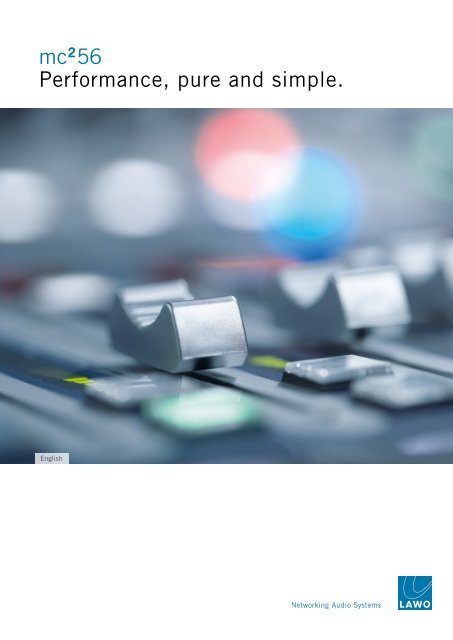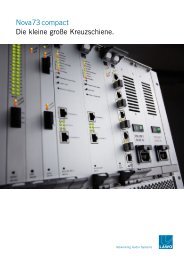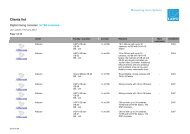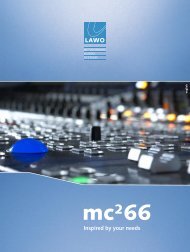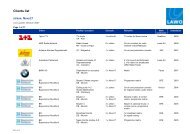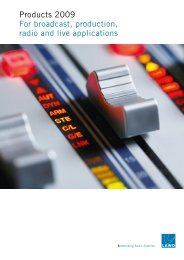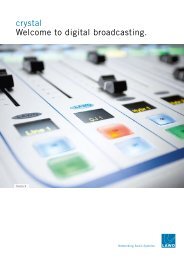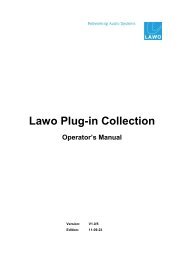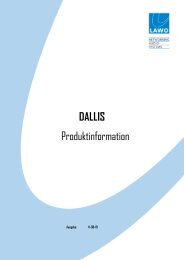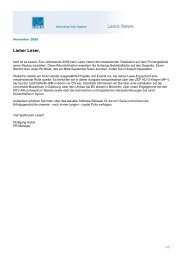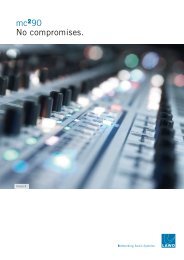Brochure mc²56 - SLG Broadcast AG
Brochure mc²56 - SLG Broadcast AG
Brochure mc²56 - SLG Broadcast AG
You also want an ePaper? Increase the reach of your titles
YUMPU automatically turns print PDFs into web optimized ePapers that Google loves.
mc 2 56<br />
Performance, pure and simple.<br />
English
<strong>mc²56</strong> — Performance, pure and simple. 1<br />
Because sometimes, less means more.<br />
What is the point of flashing control surfaces if the actual quality is not up to scratch?<br />
What is the purpose of countless features and clever gizmos, if the fundamental technology<br />
does not work. Not a lot, in our opinion. For this reason, there is now a mixing<br />
console that concentrates on essentials. Well thought out design and high functionality,<br />
featuring hi-tech components and a superb performance in day-to-day operation. The<br />
new 56 console carries a well-known seal of quality: it is a Lawo mc².
<strong>mc²56</strong> — Performance, pure and simple.<br />
The name says it all:<br />
The mc² series.<br />
The <strong>mc²56</strong> is a member of an extremely respectable family: a<br />
family that, as in real life, has various members. Irrespective of<br />
the names of the various mixing consoles — be it 90, 66 or 56<br />
— they all belong to the famous mc² family. Thus the latest addition<br />
to the mc² series is part of a tradition that always sets new<br />
standards, and a tradition founded upon three firm principles:<br />
The High-Tech principle.<br />
All mc² consoles are based on Lawo’s current HD core technology.<br />
This enables you to benefit from the best-performing routing<br />
matrices that are currently on the market. The advantages of<br />
this sophisticated leading-edge technology are absolute userfriendliness,<br />
ease of operation, and the highest reliability. In real<br />
terms, with 96 kHz operation, more than 8,000 crosspoints, over<br />
500 DSP channels, Dolby-E compatibility, and integral signal<br />
processing, HD technology offers everything you require from a<br />
modern routing matrix.<br />
The Usability principle.<br />
There are many reasons for the worldwide success of the mc²<br />
range. One of these is the exemplary ergonomic design and consistent<br />
operational philosophy found in Lawo mixing consoles.<br />
Apart from intuitive user guidance and a brief learning curve,<br />
many innovative console features help to simplify everyday work.<br />
All this lets you benefit from a number of Lawo-developed functional<br />
principles, that guarantee maximum efficiency in broadcasting<br />
operations — from user-friendly design to the pioneering<br />
concept of ‘assign at destination’.<br />
The Flexibility principle.<br />
Particularly in the development of modularity and networking,<br />
are flexible solutions becoming ever more important. It is no surprise<br />
then, that mc² mixing consoles also shine with well-conceived<br />
design. Each console is not just available in various frame<br />
sizes, but can also be expanded with additional equipment. In<br />
the case of data transfer between mc² systems, Lawo products<br />
excel thanks to their matchless networkability. Entire productions,<br />
including audio parameters, can be transferred in just one<br />
data file between different mc² consoles, thanks to Lawo’s HD<br />
core technology.<br />
The mc²90, launched in Paris in 2006, can handle the most<br />
demanding operational requirements, and has established<br />
itself as a new reference for the HD audio sector.<br />
With over 200 systems sold worldwide, the mc²66 has rapidly<br />
achieved a strong position in the market place by covering<br />
Formula One racing and World Cup football, as well as studio<br />
and OB productions.<br />
The <strong>mc²56</strong> stands out with its intelligent mix of maximum<br />
power, reduced control density and remarkably compact size.<br />
mc²90<br />
mc²66<br />
<strong>mc²56</strong><br />
2 3
<strong>mc²56</strong> — Performance, pure and simple.<br />
When performance, rather than size, is important.<br />
The <strong>mc²56</strong> is consistently designed for<br />
the best performance. For this reason,<br />
you have the same processing power with<br />
this console that already distinguishes the<br />
mc²66 and mc²90. Figuratively speaking,<br />
the “engine” and “gearbox” are the same<br />
as those used on other mc² consoles;<br />
what makes the 56 different to its siblings<br />
are its features. In the development of the<br />
<strong>mc²56</strong>, there were two core questions:<br />
which features are really required for<br />
When functionality, rather than luxury, is required.<br />
A mixing console shouldn’t just look good<br />
in the brochure, it should impress in dayto-day<br />
operation. This is why, with the<br />
<strong>mc²56</strong>, you benefit from many proven<br />
features of the mc² series — starting with<br />
the design principle of “form follows function”,<br />
through dynamic automation, and<br />
on to rapid access to the most important<br />
control parameters (‘assign at destination’).<br />
A particular feature of the <strong>mc²56</strong>,<br />
however, is the specially designed control<br />
layout. Here, the most important functions<br />
perfect sound production, and in how<br />
small a unit can you package the highest<br />
quality? The result is a control surface<br />
that reflects the maxim “reduced to the<br />
maximum”, but with a compactness that<br />
still assures maximum flexibility.<br />
The advantage: compact construction.<br />
Each fader bay has 16 faders; no wasted space between bays<br />
In a width of only 1.2 metres, the <strong>mc²56</strong> provides 32 faders in a row; when<br />
installed in the width of an OB van, 64 faders are possible<br />
Maximum configuration of 144 faders in 2.77 metres<br />
are within easy reach, while lesser-used<br />
features are accessed exclusively via the<br />
touch screen. The result is an ease of<br />
operation that really can be described as<br />
user-friendly, and a suitability in use that<br />
is best summed up as: Performance, pure<br />
and simple!<br />
The advantage: down to basics.<br />
The reduced control density makes the console highly suitable for daily use<br />
An ingenious balance between hardware buttons and touch screen operation; many<br />
additional features, eg. TC-based automation, EQ bell/shelving etc.<br />
The ability to page different channel sections assures the efficient placement of<br />
rotary controls and buttons<br />
TFT screen metering (5.1 channel), within an optimum field of view, instead of LED<br />
ladders on the faders. Clear info display via fader sense<br />
4 5
<strong>mc²56</strong> — Performance, pure and simple.<br />
Individual configurations:<br />
Making the console your own.<br />
Individuality as a standard feature – this<br />
defines intelligent technology today, and is<br />
certainly the case with the <strong>mc²56</strong>. Using<br />
an online connection, you have direct<br />
access to the hardware, and can configure<br />
the function of each user button on the 56<br />
console to suit your own requirements. In<br />
this way, you can freely, and specifically,<br />
decide which console functions you want<br />
to have immediate access to. Whether it<br />
Portability:<br />
All of the family speaking the same language.<br />
Complete compatibility and uncomplicated<br />
data transfer – this is what characterises<br />
mc² consoles. The networkability<br />
of Lawo mixing consoles does not just<br />
provide for the flexible expansion of<br />
existing mc² installations, but in day-today<br />
operation, the 100% compatibility of<br />
user data, and its tremendous benefits,<br />
will also be appreciated.<br />
be GPI controls in an OB truck, sequence<br />
automation on a theatre console, or<br />
machine control in post-production, the<br />
<strong>mc²56</strong> provides the most appropriate solutions<br />
customised to your needs.<br />
The advantage: freely assignable control presets<br />
16 freely assignable control presets can be assigned to both<br />
encoder rows for better efficiency<br />
6 freely assignable user buttons in the central control section<br />
for rapid access to the most important channel functions<br />
mc²66<br />
stereo<br />
in OB Van<br />
MOVE EDIT<br />
SNAP<br />
SEQ<br />
AUTO<br />
SET<br />
NEXT<br />
SKIP<br />
<strong>mc²56</strong><br />
portable<br />
control room<br />
PROD<br />
FILE<br />
BACK<br />
SYSTEM<br />
STATES<br />
NEXT<br />
A typical example: a production starts in stereo, using an mc²66<br />
in the OB van, and is subsequently continued with an <strong>mc²56</strong><br />
in a portable control room before the automated mix, complete<br />
with snapshots, can be completed in an mc²90 studio in 5.1 –<br />
and all this completely independent of the physical number of<br />
faders, the size of routing matrix, and the DSP capacity. Thanks<br />
to the transferability of all user data, extended configuration<br />
times can be avoided, thus leading to even further efficiency in<br />
day-to-day production.<br />
mc²90<br />
5.1 finish<br />
in the studio<br />
6 7
<strong>mc²56</strong> — Performance, pure and simple.<br />
Modularity:<br />
Because there are different solutions for different needs.<br />
What is an essential characteristic of the<br />
mc² series? Outstanding adaptability to<br />
individual requirements, and the series’<br />
modularity is of course also available in<br />
the case of the 56 console. For example,<br />
not only can you select from five different<br />
frame sizes, holding up to 80 faders,<br />
there are many options in terms of expansion<br />
and types of connection. With the<br />
<strong>mc²56</strong>, you are always geared up for the<br />
future.<br />
It won’t just be sound engineers jumping for joy:<br />
Accountants will join in too!<br />
Attractive quality at an attractive price<br />
– this was the objective for the <strong>mc²56</strong>.<br />
To reach this goal, we analysed precisely<br />
every mixing console function, and<br />
produced a clear list of priorities: “musthaves”,<br />
“good-to-haves”, and even some<br />
“unnecessary-to-haves”. This approach<br />
made it possible for us to produce a solution<br />
The advantage: frame options.<br />
Five frame sizes with 32 to 80 faders side by side<br />
Optional expansion with 16 or 32 fader bays<br />
Optional remote operation up to 32 faders via Ethernet<br />
Additional options: double fader rows; external stereo PPMs or phase meters,<br />
XLR on control surface for talkback mic<br />
with two persuasive plus points: on the<br />
one hand, the <strong>mc²56</strong> is particularly costefficient<br />
while, on the other, the console<br />
will be recognised for its simple operation<br />
and suitability for everyday use. So<br />
the <strong>mc²56</strong> won’t just preserve your<br />
budget, but also the smooth running of<br />
your broadcast facility.<br />
8 9
<strong>mc²56</strong> — Performance, pure and simple.<br />
All good things come in threes:<br />
The <strong>mc²56</strong> system elements.<br />
The <strong>mc²56</strong> system is based on three main elements:<br />
1 Mixing console control surface<br />
2 DSP and routing matrix (HD core)<br />
with integral control system<br />
3 DALLIS I/O interfaces<br />
The control surface and the HD core communicate via an<br />
optionally redundant Ethernet connection, while the DALLIS<br />
stage boxes are connected via multimode glass fibre. This<br />
enables the stage box units to be located up to 2 km from the<br />
core. An optional monomode connection facilitates distances of<br />
up to 8 km.<br />
The heart of all mc² consoles:<br />
The Lawo HD core.<br />
MADI<br />
1<br />
Ethernet,<br />
no Fibre ATM Line<br />
ATM<br />
3 3<br />
2<br />
Together with its integrated routing matrix, the mixing console<br />
provides the greatest possible flexibility in terms of I/O interfaces<br />
and DSP resources.<br />
The benefits are:<br />
Maximum of 8 DSP cards with up to 384 fully<br />
equipped DSP channels<br />
96 kHz operation<br />
Up to 144 summing buses<br />
MADI, ATM or AES connections directly to the core<br />
All conventional analogue or digital I/O and control interfaces<br />
via DALLIS<br />
Transformer microphone cards of the highest quality for<br />
critical music audio<br />
Routing matrix capacity 8192 x 8192 mono channels<br />
Hi-Tech for Hi-Fidelity:<br />
Audio processing.<br />
Audio processing takes place on DSP cards<br />
within the HD core. The core can operate<br />
at 48 or 96 kHz sampling frequency, with<br />
40-bit floating point processing, so that<br />
an internal dynamic range of 1000 dB is<br />
available.<br />
Should a DSP card fail, a redundant DSP<br />
card takes over all the crosspoints and<br />
DSP parameters within a few milliseconds.<br />
High quality algorithms ensure the finest<br />
audio processing. All DSP settings are<br />
interference-free, so that even delay settings<br />
can be made without interruption,<br />
even during runtime.<br />
All audio modules such as input mixing,<br />
filters, EQ, dynamics, delay, stereo image<br />
and surround panning are available on<br />
up to 384 fully equipped DSP channels.<br />
In addition, 32 Aux/Send feeds can be<br />
sourced from every channel.<br />
10 11<br />
Different DSP configurations enable the<br />
organisation of DSP resources according<br />
to different production requirements.<br />
Configuration changes are possible at any<br />
time during runtime, without production<br />
data being lost, or unpleasant artefacts.<br />
Even the parameters on channels that are<br />
no longer available will continue to be<br />
saved. This means that all your settings<br />
remain intact in the case of a renewed<br />
change to the DSP configuration.<br />
Surround channel with hyper-panning.<br />
What sounds good can now be particularly simple to operate. For example, you can<br />
control surround ‘bundles’ with one fader that links all channel parameters and<br />
8-channel metering. Lawo hyper-panning makes it possible to turn a surround bundle<br />
through 360°, where front width, back width and depth determine the surround source.<br />
A further benefit: a mono or stereo source positioned within a surround image can be positioned<br />
using a single control. The Reveal function opens a surround bundle onto up to<br />
eight faders, enabling direct access to all the offsets of individual channel parameters.
<strong>mc²56</strong> — Performance, pure and simple.
<strong>mc²56</strong> — Performance, pure and simple.<br />
++ mc² quality – Compact package ++ Lawo HD core technology ++ Highest functionality ++ Reduced control surface ++ Intuitive user guidance ++ Up to 80 faders ++ Available in 5 frame sizes ++ Optional expansion with extension frames ++ Intelligent mix of hardware controls and touch screen operation ++ TFT screens ++ Fader sense visualisation ++
<strong>mc²56</strong> — Performance, pure and simple.<br />
Form follows function:<br />
The <strong>mc²56</strong>’s user-friendly operating philosophy.<br />
An inspired use of colour and form,<br />
and the well-laid out design of all audio<br />
modules, provides an optimum overview<br />
in critical live situations. Due to the<br />
excellent visual feedback, EQ and pan<br />
settings can be determined at a glance<br />
from the central control panel, and the<br />
labelling of individual audio modules<br />
is virtually unnecessary. The distinctive<br />
“labelling” on all audio modules enables<br />
almost a blind understanding of the<br />
mixing console, and provides absolute<br />
certainty that you have everything under<br />
control, at each phase of a production. In<br />
addition, the console’s LED illumination<br />
means you can always locate the required<br />
functions, even under the poorest lighting<br />
conditions.<br />
In order to keep an overview of up to 144 faders, the <strong>mc²56</strong> offers colour coding of<br />
the fader strips similar to that commonly used in analogue days. However, with the<br />
<strong>mc²56</strong> you don’t need to manually change the fader caps because the fader strips are<br />
designated using modern LED technology according to the channel type or your individual<br />
requirements. This allows you to easily keep track of any fader at any stage in<br />
the production.<br />
The DSP channel.<br />
Each of the 384 fully equipped DSP<br />
channels handles all audio modules,<br />
irrespective of whether they are an input,<br />
group, summing, monitor or aux channel.<br />
As a new feature, the <strong>mc²56</strong> also has<br />
an adjustable pick-up point on the track<br />
send, which provides a dedicated track<br />
path per channel. This makes it possible,<br />
for example, to take a pre-fader feed and<br />
set a delay on the track path, which will<br />
not have any effect on the main bus sum.<br />
TRACK<br />
PATH<br />
DELAY<br />
IN MIX<br />
DIG AMP<br />
FILTER<br />
EQ<br />
IM<strong>AG</strong>E<br />
INSERT<br />
GATE<br />
EXPAND<br />
COMP LIMITER DIR OUT<br />
FADER<br />
METER<br />
BUS<br />
14 15
<strong>mc²56</strong> — Performance, pure and simple. 16 17<br />
Centre Section.<br />
The centre section is designed for maximum<br />
functionality. Its reduced width is<br />
used to house as many faders as possible,<br />
while the easily accessible buttons provide<br />
those functions that are needed for everyday<br />
operation.<br />
Configuration of the centre section control<br />
surface is carried out using the clearly<br />
laid out screen control, which provides<br />
rapid access to all important parameters.<br />
The “Access” and “Assign” functions are used to assign channels to faders. Six<br />
banks of two layers can be individually configured, and configurations can be copied<br />
between banks and layers<br />
Thanks to a comprehensive copy function, every DSP channel parameter, as well as<br />
the configuration of free controls, can be individually transferred to any channel<br />
With Fader Control, parameters such as digital amp gain, aux send level and AfV<br />
levels can be controlled directly via the 100 mm faders<br />
Individual faders can be isolated from snapshot control as well as from the control<br />
re-assignment function<br />
The <strong>mc²56</strong> centre section also provides convincing, ergonomically and optimally<br />
designed, user operation. Key functions such as strip assignment, bus combination,<br />
sequence automation and listen functions are all laid out so that they may be readily<br />
accessible in the most hectic of situations.<br />
Channel Bays.<br />
16 faders per bay<br />
Fader strip width reduced to 30 mm thanks to new mechanic construction<br />
8-character channel idents<br />
Large buttons on faders for Select, Mute, PFL, AFL<br />
Simple decentralised operation and two-person operation with individual selection of Banks 1– 6, Layer<br />
and ISO Bay function, per logical eight-wide bay<br />
Two free controls can be individually assigned and stored in snapshots, with OLED display for visual feedback<br />
Clear, high-resolution and easy-to-read metering on 16:10 TFT screens<br />
Visual feedback of metering in stereo or surround, bus assignment, input gain, free control assignments<br />
Visualisation by touch sense function allows intuitive channel assignment
<strong>mc²56</strong> — Performance, pure and simple.<br />
New efficiency in audio production:<br />
Snapshots.<br />
Comprehensive snapshot features make it possible to save<br />
control surface assignments, DSP settings, routing matrix<br />
connects and I/O parameters. Using the filter function, groups of<br />
controls, and individual controls or signals can be isolated. All<br />
functions can be recalled directly from the snapshot page as well<br />
as from a special snapshot/sequence control unit.<br />
Sequences are assembled from snapshots, and their position in<br />
a sequence can be changed at any time; there is no limit to the<br />
number of snapshots per sequence. Snapshot data can be transferred<br />
via the network or USB links.<br />
The <strong>mc²56</strong> sequence automation system enables you to manage<br />
a number of different sequences without having to export data.<br />
Functions such as cross-fading individual parameters between<br />
two snapshots, and firing MIDI commands, add to the functional<br />
scope of the <strong>mc²56</strong>’s sequence automation.<br />
New efficiency in audio production:<br />
Dynamic automation.<br />
The completely new Lawo Dynamic Automation* is particularly<br />
designed for use in modern production studios and mobile<br />
control rooms. The automation system follows the mc² series’<br />
principles of operation, and enables fast and easy access to mix<br />
data, with maximum flexibility. Based on the “Assign at Destination”<br />
principle, all mix parameters can be directly set, and the<br />
sound engineer can match any mixing requirement swiftly and<br />
precisely.<br />
Trim-Parameter and Oversnap functions.<br />
Snapshots can now also be loaded with trimmed parameters.<br />
In other words, individual sections of a channel can be given<br />
an offset or written absolutely into a sequence. The trimmed<br />
settings can also be stored in so-called Oversnaps. This makes it<br />
possible to save and recall different Oversnaps as and when you<br />
need them — a feature that will make your work much simpler,<br />
particularly in the case of productions that feature a number of<br />
different soloists.<br />
A mix pass tree diagram enables alternative mixes to be<br />
simply selected<br />
Switching between mix passes with concurrent timecode<br />
allows mixes to be easily compared<br />
The dynamic automation provides a comprehensive record<br />
of all DSP processing over the complete timeline<br />
Individual channel sections or groups of sections can be<br />
recorded static-dynamically or fully dynamically, at any time<br />
Stepout modes, Copy functions and Preview or Bypass facilities<br />
will assist you to create enjoyable and individual mixes<br />
18 19
<strong>mc²56</strong> — Performance, pure and simple.<br />
When the ear follows the eye:<br />
Audio-follow-Video.<br />
The <strong>mc²56</strong> offers a flexible and comprehensive<br />
Audio-follow-Video function<br />
(AFV) on every channel. A defined event is<br />
assigned to each camera tally; this event<br />
can be selected for one or more channels,<br />
and 128 events are available. In addition,<br />
by the setting of rise time, on time and<br />
fall time parameters, the envelope of the<br />
process can also be defined. This enables<br />
soft pans from camera to camera to be<br />
easily handled. Efficiency in operation?<br />
– you can set each change of the AFV<br />
directly, using rotary encoders on the<br />
control surface, without having to search<br />
endlessly through screen menus. Using<br />
the Hold Time function, a newly developed<br />
feature available for the first time on the<br />
<strong>mc²56</strong>, you can configure a ramp so that,<br />
with an tally active, the AFV function will<br />
only start after a defined time.<br />
Hold Time Max Event Time<br />
Rise Time<br />
Event On Event Off<br />
On Time Fall Time<br />
On Level<br />
Off Level<br />
Fitting together:<br />
mc² series networkability.<br />
Optional facilities enable up to 16 Lawo<br />
consoles and a Nova73 to be networked.<br />
This allows you to freely distribute your<br />
I/O resources among the networked<br />
systems, and use Netlinks (MADI, ATM,<br />
AES or analogue audio) to connect different<br />
Lawo consoles to a large routing<br />
matrix. The benefits are clear:<br />
Networking<br />
<strong>mc²56</strong> / 66 / 90<br />
HD Core<br />
<strong>mc²56</strong> / 66 / 90<br />
HD Core<br />
The complex networked systems appear in operation as<br />
one routing matrix<br />
Local sources and feeds are available to other consoles on the<br />
network, at the push of a button<br />
Every consoles can access all parameters (e. g. mic preamp,<br />
low-cut filter, SRC, etc.), irrespective of whether the sources<br />
and feeds are local or networked<br />
Netlink 2<br />
Netlink 1<br />
Netlink 3<br />
<strong>mc²56</strong> / 66 / 90<br />
HD Core<br />
20 21
<strong>mc²56</strong> — Performance, pure and simple.<br />
Innovation in everyday work:<br />
The General Purpose Channel.<br />
The General Purpose Channel (GPC) is a type of channel in the<br />
<strong>mc²56</strong> control system that contains all the channel sections of<br />
a normal input channel (input mixer, EQ, dynamics, panning,<br />
fader level, aux, AFV, etc.). The GPC is not, however, directly<br />
linked to the signal processing, but to the console’s MIDI and<br />
Ethernet interfaces. The <strong>mc²56</strong> offers various mapping tables,<br />
which you can use to control digital audio workstations or various<br />
other MIDI-controlled devices.<br />
A world’s first for Lawo:<br />
Complete plugin integration for mixing consoles.<br />
Naturally, all the parameters can also be saved in snapshots<br />
and recalled at any time. In addition, the <strong>mc²56</strong> provides the<br />
possibility of using both dynamic automation as well as the AFV<br />
function with GPC parameters. A further application of the GPCs<br />
is the control of camera microphones — you adjust the setting of<br />
a camera microphone directly from the <strong>mc²56</strong> control surface,<br />
and save the parameters in a snapshot.<br />
With the Lawo Plugin Server you gain from the benefits of two<br />
completely different worlds. Thanks to comprehensive plugin<br />
integration, it is now possible to use the live mixing facilities<br />
of the mc² series, while easily accessing the widest range of<br />
“outboard” FX. With this exciting new application, Lawo provides<br />
demanding audio engineers with a genuine innovation that<br />
opens up completely new possibilities in audio production,<br />
offering undreamed-of flexibility for live and studio situations.<br />
All plugin parameters can, of course, also be imported directly<br />
into the mixing console and saved in snapshots.<br />
<strong>mc²56</strong>:<br />
Console dimensions and frame sizes.<br />
Per 16 fader extension plus 510 mm width<br />
16 + 16 C<br />
16 + 16 C + 16<br />
32 + 16 C<br />
32 + 16 C + 16<br />
32 + 16 C + 32<br />
16 /32 Extender<br />
e.g. OB Mounting,<br />
Flyway Kit<br />
Width: 1257 mm<br />
Weight: 62,8 kg<br />
Width: 1767 mm<br />
Weight: 87 kg<br />
Width: 1767 mm<br />
Weight: 87 kg<br />
Width: 2277 mm<br />
Weight: 115,2 kg<br />
Width: 2787 mm<br />
Weight: 143,3 kg<br />
22 23
<strong>mc²56</strong> — Performance, pure and simple.<br />
Technical Details:<br />
Everything at a glance.<br />
Control Panel<br />
Frames from 16 + 16 faders to 64 + 16 faders<br />
Remote Frames 16 and 32 Faders<br />
6 banks per 2 layers each<br />
100 mm faders + 2 rotary controls free assignable + Input Gain<br />
Controller, channel display for every fader with sense-triggered<br />
change of module display in the Channel Display<br />
TFT metering mono, stereo or 7.1 including bus assignment,<br />
gain reduction for dynamics, AfV status, VCA assignment<br />
External display of GUI Pages e.g. metering<br />
Desk Light per bay<br />
6 User Buttons<br />
Optional: script tray, PPM integration, T / B mic integration<br />
Signal Processing<br />
512 channels and 144 summing buses, 40 bit floating point<br />
Up to 376 inputs with A / B input, 48 sub groups, 32 aux<br />
sends, 96 track busses, 48 main sums, change on the fly<br />
from mono to stereo to surround channel and bus<br />
Up to 64 surround channels, 128 VCA groups with metering,<br />
256 GPC Channels<br />
Surround formats: DTS / Dolby Digital 5.1, Dolby Pro-logic 4.0,<br />
DTS ES / Dolby EX 6.1, SDDS 7.1, DTS-HD 7.1, diverse<br />
panning characteristics, surround aux bus<br />
2* AFL: 1*surround 8-channel, 1*stereo<br />
2* PFL stereo<br />
Audio-follow-Video with 128 events, control either via Remote<br />
MNOPL, GPI or Matrix Connect, adjustable envelope up<br />
to 10 s fade time<br />
Solo In Place<br />
Permanent input measuring point in the fader, adjustable<br />
measuring points INPUT, PF, AF, DIROUT in the Channel Display<br />
Modules: Inmix with MS-Decoder, Digital Amp, 2-band fully<br />
parametric Filter, 4-band fully parametric EQ, 2-band fully<br />
parametric Sidechain Filter, Insert, Delay up to 1800 ms,<br />
units in frm, ms and m, 4 independent Dynamics: Expander,<br />
Gate, Compressor, Limiter; Image, Meter, Direct Out<br />
Inline configuration with send/return switching – at the<br />
channel or global<br />
Fully equipped surround channel with coupling of all channel<br />
parameters and Hyper Panning<br />
Routing Matrix<br />
8192 x 8192 crosspoints, non-blocking<br />
96 kHz, 24 bit<br />
Fully redundant signal path<br />
Level adjustment for all Inputs and Outputs<br />
Downsizing up to 7.1 to Stereo<br />
Integrated monitoring devices for remote positions e.g.<br />
Director Room<br />
Full networking of up to 16 HD Cores, share and import<br />
of sources and destinations, studio arbitration<br />
Full snapshot and production portability independent of<br />
matrix or DSP size<br />
Plugin Server<br />
Full VST plugin integration with storing of plugin parameters<br />
in snapshots and productions<br />
Interfaces<br />
Mic / Line, Line Out, AES, SDI, MADI, ATM, GPIO, Serial, MIDI<br />
(for details see DALLIS product information)<br />
Monitoring systems stereo and surround<br />
Synchronisation<br />
2 redundant inputs with automatic detection of Blackburst,<br />
Wordclock, AES3, MADI<br />
Redundancies<br />
PSUs, DSP boards, router board<br />
Fully redundant signal path<br />
Redundant control system<br />
PSU for control system and control panel<br />
Control<br />
Bay-Iso with separate layer and bank switching as well as<br />
2nd PFL / AFL bus<br />
Global A / B input switching<br />
Enhanced mix-minus (N-M) control with independent<br />
off-air conference<br />
Fader control of all level parameters<br />
Diverse tally- and faderstart modes<br />
Program switch<br />
Machine control<br />
Audio-follow-Video, up to 128 camera tallies, Ethernet or<br />
GPI-controlled<br />
Manifold T / B integration<br />
Camera microphone remote via GPI or voltage control<br />
External Control Systems<br />
Remote control via network of all routing parameters<br />
Remote control of monitoring units of remote positions<br />
Online configuration with AdminHD, graphical configuration<br />
of HD Core components<br />
External matrix controller: VSM, Jupiter, BFE and others<br />
Remote Maintenance<br />
Connection via Internet Remote Software<br />
Software updates, error diagnostics, remote<br />
As of May 2010. Subject to change without prior notice,<br />
no responsibility is taken for the correctness of the details provided.<br />
24
Headquarters<br />
Lawo <strong>AG</strong><br />
Am Oberwald 8<br />
76437 Rastatt<br />
GERMANY<br />
Phone + 49 7222 1002 0<br />
Fax + 49 7222 1002 7101<br />
info@lawo.de<br />
www.lawo.de<br />
Subsidiaries<br />
Lawo International GmbH<br />
Wehntalerstrasse 58<br />
8157 Dielsdorf<br />
SWITZERLAND<br />
Phone + 41 43 38868 00<br />
Fax + 41 43 38868 09<br />
info@lawo.ch<br />
www.lawo.ch<br />
Lawo North America Corp.<br />
1361 Huntingwood Drive, #16<br />
Toronto, Ontario M1S 3J1<br />
CANADA<br />
Phone + 1 416 292 0078<br />
Fax + 1 416 292 0402<br />
info@lawo.ca<br />
www.lawo.ca<br />
Lawo Australia Pty Ltd<br />
P.O. Box 270<br />
Brown Hill<br />
Victoria 3350<br />
AUSTRALIA<br />
Phone + 61 3 5309 2647<br />
Fax + 61 3 8677 9973<br />
info@lawo.com.au<br />
www.lawo.com.au<br />
Representative Offices<br />
Lawo International GmbH<br />
Singapore Representative Office<br />
7030 Ang Mo Kio Ave 5<br />
#06-06, Northstar@AMK<br />
Singapore 569880<br />
SINGAPORE<br />
Phone +65 9818 3328<br />
Fax +65 6255 7651<br />
boonsiong.tan@lawo.sg<br />
Lawo <strong>AG</strong> Beijing<br />
Representative Office<br />
Room 1101, Block A, Luo Wa Plaza,<br />
No. 203, Zone 2, Li Ze Zhong Yuan<br />
Wang Jing, Chaoyang District<br />
100102 Beijing<br />
P. R. CHINA<br />
Phone + 86 10 6439 2518<br />
Fax + 86 10 6439 1813<br />
francis.he@lawo.cn<br />
www.lawo.cn<br />
Printed in Germany | As of May 2010


